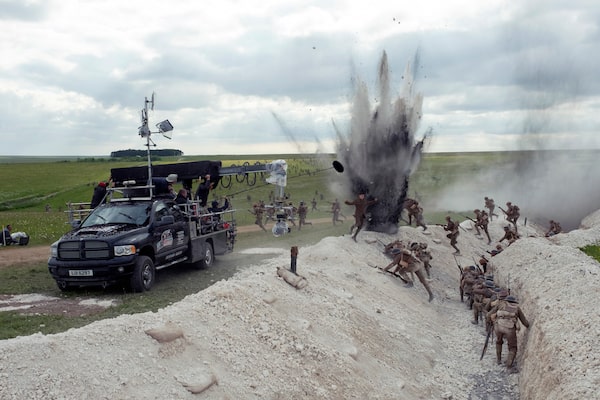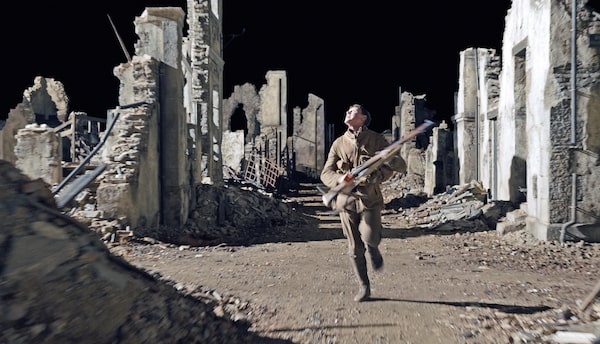
George MacKay as Schofield in '1917,' the new epic from Oscar-winning filmmaker Sam Mendes.Photo Credit: Universal Pictures/Universal Pictures
If you know anything about Sam Mendes’s new movie 1917, which opened in Toronto and select U.S. cities on Christmas Day, it is that the First World War thriller is a "one-shot’ film. Meaning that the filmmakers have constructed the tale of two young British soldiers on a deadly mission in Northern France to appear as if it was filmed in a single continuous take in real-time, with no edits or cuts to second locations or temporal jumps.
Unlike Aleksandr Sokurov’s 2002 drama Russian Ark or Sebastian Schipper’s 2015 crime film Victoria, both of which are “authentic” one-shot films in that they started rolling the camera and didn’t stop for the duration of their respective lengths, there is a lot of cinematographic and digital trickery going on with 1917, resulting in a fun if somewhat distracting game of “spot the hidden cut.” After all, it would be impossible, or at least it would cost hundreds of millions of dollars and the sanity of dozens of production managers, to actually produce an explosion-filled war epic – filled with thousands of extras and relying on the temperament of British weather --- that was captured in one actual take.
But what a lot of the current conversation and marketing around 1917′s “one-shot” conceit is missing is that the film is actually – giant spoiler alert! – two shots. If you want to save any of 1917′s surprises for yourself, I suggest that you stop reading now. For those ready to head to the front-lines of Mendes’s trickery, though, strap in.
So: At exactly one hour, six minutes, and 13 seconds into Mendes’s film, Lance Corporal Schofield (George MacKay), whom we’ve been following since the very first frame of the movie with no pause, is knocked unconscious by fire from an enemy soldier after he investigates the inside of a bombed-out building. The screen then cuts to black – a break lasting 16 seconds. When Schofield awakens, we’ve now jumped in time a few hours, as the sky is pitch-black. Briefly, cinematographer Roger Deakins’s camera also takes a break from exclusively tracking Schofield’s movements to swoop outside the staircase that the soldier’s holed up in, showcasing a French village on fire – as if our hero woke up in his own private hell. Suddenly, a one-shot movie turns into a two-shot movie. Which, according to the filmmakers, was always the plan.

The filmmakers have constructed the tale of two young British soldiers on a deadly mission in Northern France to appear as if it was filmed in a single continuous take in real-time, with no edits or cuts to second locations or temporal jumps.Photo Credit: François Duhamel/Universal Pictures
“At our very first structure meeting, Sam mentioned that we always wanted to from dusk onward, and then from night till dawn. So we had an idea that we were going to have a break like that,” says Krysty Wilson-Cairns, who co-wrote the film with Mendes. “We’ve set the rules to the world, and then pulled the rug out from under you. It adds an extra layer of jeopardy, because everything that happens after that – when the camera leaves Schofield and goes through the window – it breaks what we’ve done before and allows the camera and set design to externalize Schofield’s fears.”
The soldier is now profoundly confused and lost and on the edge of giving up. But given that he is also the only character on-screen at that moment, the filmmakers thought it would seem hokey to have him reveal all those emotions in a monologue delivered to himself. “In real life, no one wakes up and says, ‘I hit my head … am I alive or dead?’ We had to use the tools of film in a groundbreaking way, so rather than focus on dialogue, use the cameras and sound to make that bit really work,” says Wilson-Cairns.
“Structurally, it allowed us to go somewhere else, and shift from being a more naturalistic story to something more mythic,” adds Mendes, the Skyfall director who based 1917′s story very loosely on the war stories of his grandfather, Alfred. “I felt the movie needed another tone, something that you didn’t see coming. It also enabled us to work with a different atmosphere and palette, with a different context. And when the camera detaches from Schofield, that was a very carefully considered moment. He’s struggling to get back to the land of the living, to bring himself back into life again.”
The filmmakers also emphasize that the one-shot – or rather two-shot – conceit is far from a gimmick.

What a lot of the current conversation and marketing around 1917′s 'one-shot' conceit is missing is that the film is actually – giant spoiler alert! – two shots.Photo Credit: Universal Pictures/Universal Pictures
“They can say that this film is a gimmick in the way we shot it, but editing is a gimmick, too – that’s not how you perceive the world. So what we’re trying to be with this film is as organic as possible, as close to reality as possible,” says Wilson-Cairns. “There’s no exposition. It’s all shot in natural light. Everything was made to feel more and more real. It’s never, ‘Look how cool we are.’ It’s always in service of character and story.”
“After I sent Roger the script, it was all about, okay, what’s the style of the one-shot and how do we develop it for the movie that’s not repetitive or self-advertising or gimmicky? And that’s the style here of shifting between the audience and the character,” adds Mendes, who with 1917 has made his second war movie with Deakins, after the pair’s 2005 Gulf War drama Jarhead. “You do forget about it, and just watch the story. Every second it passes is the same second for you.”
Well, almost every second.
1917 is now playing in Toronto, and opens across the country Jan. 10
Live your best. We have a daily Life & Arts newsletter, providing you with our latest stories on health, travel, food and culture. Sign up today.
 Barry Hertz
Barry Hertz